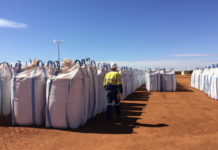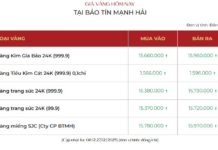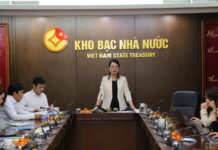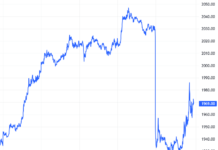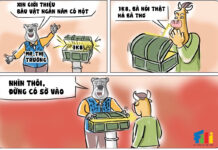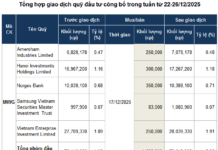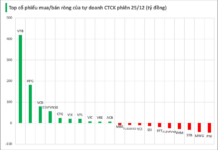
Mr. Pham Xuan Hoe shared at the Talk. Screen capture
|
At the seminar “Identifying the Economy in the First Quarter: Opening the Way for the Economy in 2024”, Dr. Pham Xuan Hoe – Former Deputy Director of the Institute of Banking Strategy shared his opinions on investment cash flow in the market, credit, inflation, and interest rates.
Money supply stagnation slows down lending interest rates more than deposit interest rates
“Perhaps for the transition to a market economy, no country has such a short economic cycle as Vietnam, only 10 years/time. China has been growing by 14-15% since 1978, and maintained such growth for a long time. It was only last year that it began to decline, or Japan has had a continuous economic growth cycle for more than 30 years. To maintain the business cycle of the economy or not depends entirely on the Government’s macro-management policies. If nothing happens or suddenly changes, the economy will just be mediocre”, Mr. Hoe shared.
Going into detail about credit supply, Mr. Hoe emphasized: “Fortunately, credit did not fall in the first quarter of 2024 because the credit growth in 2023 was characterized by an abnormality: In just the last 20 days of December, Vietnam’s credit growth reached 4.56%. And so when talking about money supply, M2 in 2022 only increased by 6.56%, causing the economy to keep lacking money at the time, while businesses found it difficult to pay for their liquidity. Following the formula recommended by IMF (International Monetary Fund) on developing monetary policy, M2 must be equal to growth plus inflation, which means that the M2 growth should have exceeded 9%. In 2023, the M2 growth exceeded 13%, and so evidently if calculated based on the formula, it will equal the credit growth plus growth of foreign currency net assets, in which foreign currency net assets fell, and the cash flow sent abroad exceeded the cash flow received in the country; the foreign currency net assets will be equal to business profits transferred back by FII and a part of foreign currency capital mobilized by credit institutions at a rate of 0%.
Explaining why Vietnam’s deposit interest rates fell so fast and the State Bank reduced the interest rates four times yet the lending rates in the market remained high is due to stagnation in money supply. Market 1 (relations between banks, businesses, and people) and Market 2 (transactions between banks) are not interconnected.
According to the expert, another issue to note is that the total bad debt of Vietnam’s credit institutions, according to the report of the State Bank of Vietnam, is a total of over 6%, including both on-balance sheet and off-balance sheet debts, plus the amount restructured under Circular 02 (extending repayment time), at roughly VND 180 trillion (around 1.3%). Therefore, the actual total bad debt of Vietnam’s credit institutions is 7.3%. The elements that determine the lending interest rate are input interest rates plus risk compensation, then with high risk compensation, the lending interest rates will also be high, adding to the operating costs, and the salary plus the interest spread, and the NIM of many commercial banks remain somewhat high, at over 4%, and hence, it is evident that the sharing with businesses is not yet balanced.
Gold attracts a strong cash flow
Observing the cash flow in the four investment channels, Mr. Hoe pointed out that bank deposits have been at their lowest interest rates in years, which benefits the economy if lending interest rates are reduced accordingly. In the first quarter, deposits in credit institutions fell by 0.76%, compared with GDP, with savings accounting for 27.7%. Previously, in 2023, deposits reached a record high of over VND 14,000 trillion, which is natural as deposits tend to increase as inflation and GDP increase. The deposit growth in 2023 was due in part to high deposit interest rates in 2022, at 9-10%, and the rate at which capital was input saw a 9% rise.
Mr. Hoe confirmed that the deposit decline in the first quarter was due to a shift towards gold. The expert indicated that a significant amount of money has been poured into gold accumulation and investment. As evidence, PNJ has revenue exceeding VND 30 trillion and profit exceeding VND 1 trillion, and SJC has revenue exceeding VND 30 trillion. Central banks have also bought 800 tons of gold as of the third quarter of 2023 and will continue to buy heavily in 2024.
“Gold rose roughly 23% in the first quarter, meaning that just holding gold from the beginning of the year to now, you would have earned a 23% profit. Each year, Vietnam consumes on average 55 tons of gold, of which gold production is at 3-4 tons, and around 50 tons are imported. When the State Bank of Vietnam and functional agencies prohibit importation, illegal importation will occur, leading to capital flight. This is also a factor putting pressure on the exchange rate between the USD and VND”, Mr. Hoe stated.
Cash also flowed into the stock market, with the domestic cash flow balancing out with the VND 8,000 billion of net sales by investors in the first quarter, and the number of newly opened accounts reaching up to 401,000, while the average daily trading value climbed to VND 27,300 billion, a 35% increase compared to the same period last year, demonstrating that the cash flow into the stock market is relatively large. In addition, the real estate channel also witnessed a significant recovery in cash flow. Mr. Hoe provided statistics showing that the proportion of cash flow recovery in real estate rose to 21.5%, higher than banking at 17.8% and stocks at 15.5%.
“With access to low-interest loans for real estate investment, the cash flow from remittances at VND 14 billion/year, and especially the opportunity for real estate businesses to actively restructure bonds, these are positive factors in the recovery of the real estate market”, Mr. Hoe stated.
Deposit interest rates will increase in the future
Looking at the long-term deposits in banks, which are in decline, but short-term deposits are increasing. Therefore, Mr. Hoe predicted that in order to increase the cash flow, banks will have to incentivize by raising deposit interest rates (forecast to increase by around 0.5-0.8%/year), while the lending interest rates will only increase slightly more than the deposit interest rates due to weak credit demand.
Mr. Hoe also predicted that inflation may also rise a little from now until the end of the year due to factors such as the increasing exchange rate leading to higher input costs, improving salaries, and lingering psychological effects (expected inflation), which will push up interest rates.
Mr. Hoe assessed that compared with the current high rise, the exchange rate will gradually move towards stabilizing somewhere around 3-3.5% by the end of the year, since Vietnam has maintained a trade surplus, Vietnam’s economic situation with foreign countries remains relatively stable, and foreign currency reserves, as well as the State Bank of Vietnam’s intervention, will be smoother.
In response to the question of whether the Vietnamese currency is cheap or not, the expert affirmed that the Vietnamese currency is not cheap yet. Deducting from the current real lending interest rates in the market with inflation, the rate is still quite high, at around 3.5-4%. Only businesses that are genuinely strong can take out loans at low interest rates, possibly 5-6% for short-term capital, but normally the rate would be around 7-8.5% for short-term capital, and 9-10% for medium- to long-term capital.


